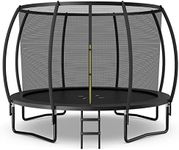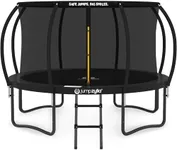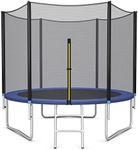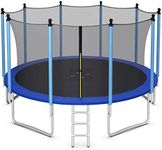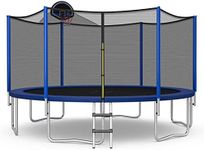Buying Guide for the Best Outdoor Trampolines
Choosing the right outdoor trampoline can make a big difference in safety, fun, and durability. Before you buy, think about who will be using the trampoline, how much space you have in your yard, and what features matter most to you. It's important to balance safety, size, and quality to ensure you get a trampoline that fits your needs and lasts for years.Size (Diameter)The size of a trampoline, usually measured in feet across the diameter, determines how much jumping space you have. This is important because a larger trampoline can accommodate more users and allows for more movement, while a smaller one fits better in limited spaces. Trampolines typically range from about 8 feet (good for small children or tight spaces), to 12-14 feet (a popular middle ground for families), up to 15 feet or more (best for multiple users or older kids and teens). To pick the right size, consider the age and number of users, as well as the available space in your yard—always leave extra room around the trampoline for safety.
Weight LimitThe weight limit tells you the maximum combined weight the trampoline can safely support. This is crucial for safety, as exceeding the limit can damage the trampoline or cause injuries. Weight limits can range from around 150 pounds (suitable for young children) to over 400 pounds (for multiple users or adults). Choose a trampoline with a weight limit that matches the heaviest expected user or the combined weight of multiple users if they will be jumping together.
Frame MaterialThe frame material affects the trampoline's strength and resistance to weather. Most outdoor trampolines use steel frames, but the quality and coating can vary. Galvanized or powder-coated steel resists rust and lasts longer outdoors. If you live in a humid or rainy area, prioritize rust-resistant frames. For most users, a sturdy, well-coated steel frame is the best choice for long-term durability.
Safety EnclosureA safety enclosure is a net that surrounds the jumping area to prevent falls. This is one of the most important safety features, especially for children. Some trampolines come with high, tightly-woven enclosures, while others may have lower or looser nets. Look for an enclosure that is tall enough to prevent users from bouncing over and securely attached to the frame. If safety is a top concern, always choose a trampoline with a robust enclosure.
Spring Type and PaddingThe springs provide the bounce and affect how soft or firm the trampoline feels. Longer, higher-quality springs usually offer a smoother, higher bounce, while shorter springs may feel stiffer. Padding covers the springs and frame to prevent injuries. Thick, weather-resistant padding is important for safety and comfort. If you want a gentler bounce for younger kids, look for trampolines with more or longer springs and thick padding.
ShapeTrampolines come in different shapes, such as round, rectangular, and oval. Round trampolines are most common and tend to direct jumpers toward the center, which is safer for families. Rectangular trampolines offer more even bounce across the surface and are often preferred by gymnasts or athletes. Oval trampolines provide a mix of both. Choose the shape based on your space, intended use, and user experience level.
UV and Weather ResistanceSince outdoor trampolines are exposed to sun and rain, materials that resist UV rays and moisture will last longer and stay safer. Look for trampolines with UV-protected mats and weather-resistant padding and netting. If your trampoline will be in direct sunlight or exposed to the elements, prioritize these features to reduce fading, cracking, and wear.




